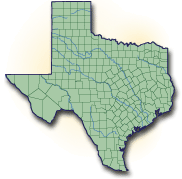As a first priority of the partnership, NCTCOG and FEMA completed the Flood Map Modernization initiative in 2000. This important effort recognized the need for the update of flood insurance studies and flood insurance map panels. Equally important was the development of digital flood hazard mapping.
FEMA's Flood Map Modernization Program
Several important events occurred in the period from 1995 to 2002 that led to a FEMA Map Modernization Initiative to update flood insurance studies and develop digital flood hazard mapping nationwide over a five-year time frame. The completion of a Map Modernization Study in 2000 by the Technical Mapping Advisory Council recommended a multi-year national mapping program to update approximately 100,000 flood insurance map panels across the nation.
Based on population metrics, FEMA Region VI determined that within the NCTCOG region, Collin, Dallas, Denton, Ellis, Erath, Hood, Hunt, Johnson, Kaufman, Navarro, Palo Pinto, parker, Rockwall, Tarrant and Wise counties would be studied between 2004 and 2010, beginning with Collin, Dallas, Denton and Tarrant.
The ultimate goal of these studies was to produce Digital Flood Insurance Rate Maps, referred to as DFIRMs. Paper maps can be printed from the DFIRMs.
Nationally, the engineering firm Michael Baker Jr., Inc. (Baker), along with its team of subcontractors, was awarded a five-year contract to serve as the National Service Provider (NSP) to develop, plan, manage, implement, and monitor the Map Modernization program for flood hazard mitigation across the United States and its territories.
Baker assisted FEMA in working with state, local, and other Federal partners to develop digital flood and multi-hazard data for the entire United States, including the establishment of 10 Regional Management Centers across the country to manage and monitor flood studies locally and provide support to FEMA’s 10 regional offices. For assistance with information technology, Baker subcontracted with IBM Business Consulting Services to aid in the development of a Multi-Hazard Information Platform (MIP). The MIP is a national digital depository that will store, manage, and provide remote access to all the information generated from the Map Modernization program.
 In the NCTCOG region, FEMA Region VI contracted with Halff Associates for the studies in Dallas and Tarrant counties. For the studies in Denton and Collin counties, FEMA Region VI contracted with Comprehensive Flood Risk Resources & Response (CF3R). CF3R is a Joint Venture comprised of Michael Baker, Jr., Inc. (Baker), Carter & Burgess, Inc. (C&B - now Jacobs Engineering Group Inc), CDM Federal Programs Corp. (CDM), and Moffatt & Nichol Engineers (M&N).
In the NCTCOG region, FEMA Region VI contracted with Halff Associates for the studies in Dallas and Tarrant counties. For the studies in Denton and Collin counties, FEMA Region VI contracted with Comprehensive Flood Risk Resources & Response (CF3R). CF3R is a Joint Venture comprised of Michael Baker, Jr., Inc. (Baker), Carter & Burgess, Inc. (C&B - now Jacobs Engineering Group Inc), CDM Federal Programs Corp. (CDM), and Moffatt & Nichol Engineers (M&N).
In order to maximize the use of available funding, Halff Associates and CF3R conducted scoping activities with all local communities in the 4-county study area during the summer of 2004. The scoping effort resulted in a determination of additional flood hazard mapping needs and a prioritization of streams and watersheds. Because of fiscal constraints, all streams and watersheds were not studied.
During the fall of 2004, FEMA Region VI, the NSP and the study contractors reached agreement on the proposed scope of work, and the studies were officially kicked off. Once the preliminary DFIRMs were produced, all local communities were asked to review and provide comments. Also during this conversion period, all local communities needed to revise their ordinances/court orders in order to adopt the new maps when they became effective. This conversion period provided an excellent opportunity for local communities to incorporate more stringent (or “higher standard”) floodplain management measures into their ordinances/court orders.
To help make the most of available funding, FEMA Region VI, the NSP and the study contractors requested the assistance of NCTCOG in a variety of ways. NCTCOG, in conjunction with its members, has facilitated the cooperative purchase of digital orthophotography and LIDAR topography. Because the LIDAR topography is a consistent dataset across the main 4-county study area of Collin, Dallas, Denton and Tarrant Counties and because the LIDAR topography is the best available topographic data in many parts of that study area, NCTCOG coordinated an agreement with FEMA Region VI and the study contractors to integrate the LIDAR topography where needed. Additionally, FEMA Region VI, the NSP and the study contractors looked to NCTCOG for help with DFIRM base mapping (particularly, regional vector-based information for stream lines, the transportation network, jurisdictional boundaries, etc.). Beyond mapping assistance, NCTCOG continued to help FEMA Region VI, the NSP and the study contractors by providing support through various outreach and study coordination activities.